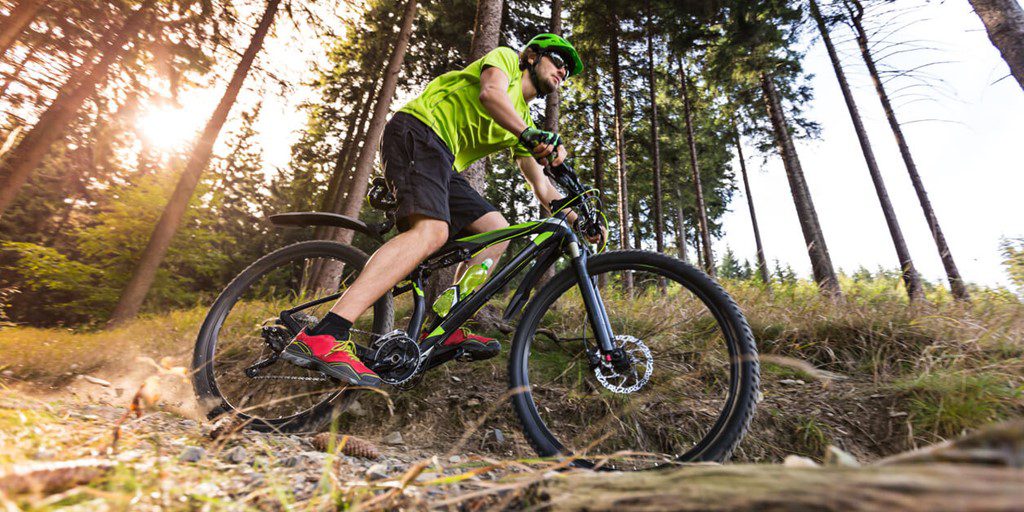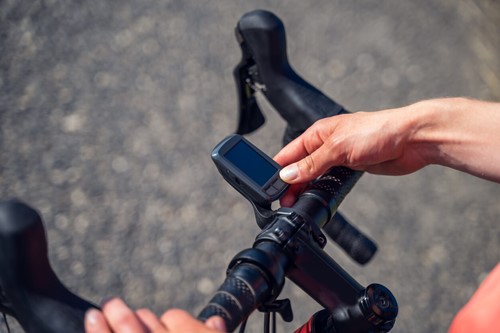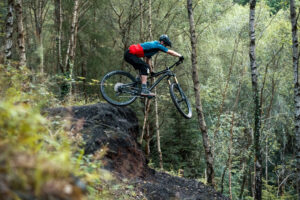9 safety tips for mountain biking

Thinking about heading out on the trails? Before you get kitted up and go, there are some mountain biking safety tips you should know.
Cycling downhill at speed and launching over drops is thrilling, but it’s important to keep control of your bike. Without the right equipment and a thorough risk assessment, you could land yourself in a sticky situation.
Here you’ll find all the safety considerations for mountain biking you need for a great riding experience and to stay out of harm’s way.
One of the most obvious yet important safety tips for mountain biking is wearing a helmet.
They may not be the most aesthetically pleasing forms of safety equipment, but they’ve been found to reduce serious head injuries by almost 70%.
Since the nature of this activity makes underestimating turns, bumps, and other obstacles likely, it’s important to protect your head if you crash or fall. Brain injuries can be incredibly life-changing or even fatal, so it’s important to reduce the risk of serious trauma to this area.
Want to ensure your helmet offers ultimate safety? Follow the video below to get the correct fit.
Aside from your helmet, you should ensure that safety and comfort are prioritised in the other gear you select for use out on the trails.
Firstly, your riding apparel should be appropriate for mountain biking. Your road biking gear will need some changing up if you’re switching terrain, as there are a few clear differences that require separate gear.
Here’s a full breakdown of what you’ll need:
Body armour may seem a bit over the top if you’re new to off-road cycling—but depending on the trails you’ll be riding on, it could be crucial for protecting vulnerable areas of your body.
Related: The essential bike safety gear for your next ride
One of our biggest mountain biking safety tips is to always ensure you pack a first aid kit.
You’ll most likely encounter obstacles along your path—from exposed tree roots to sharp rocks—which can cause a nasty injury.
Whether you snag your leg on a bramble or break your collarbone (one of the most common cycling injuries), a first aid kit can help patch you up until you can get further medical assistance.
You should purchase a kit that includes all the first aid staples, such as:
plasters
dressings
scissors
medical tape
latex gloves
antiseptic wipes/cream
painkillers
tweezers
eyewash
It’s also good to carry a triangular bandage if you’re unlucky enough to injure your collar bone and need a makeshift sling. A foil blanket is another useful item for cyclists, especially if you sustain an injury in cold weather.
Related: The most important supplies for your mountain biking first aid kit
To keep your energy levels up during your rides, you should fuel up before heading out.
Eating a high-carbohydrate meal beforehand is one of our top safety tips for mountain biking, as it will keep you energised for a longer duration of time.
Want to avoid a dip in energy during your ride? Reaching for energy gels is never a bad idea, as they’re an easily digestible energy source that kicks in right away. Bananas are another popular mid-ride snack but be sure to store them at the top of your backpack.
Maintaining a good hydration level is another key safety tip for mountain biking, especially since it’s unlikely you’ll be able to drop into a shop if you forget your water bottle.
Always ensure you drink enough in the hours leading up to your ride, and don’t forget your water bottle or energy drink.
It’s also good to check out recovery meals for cyclists, as eating to recover is just as important as fuelling up before your ride.
Related: The top 5 cycling hydration tips
When developing your skill level in mountain biking, it can be tempting to push yourself to reach that next milestone. But this is a dangerous sport with a high risk of injury, so pacing yourself is important.
Taking your time and ensuring you maintain control of your bike is one of the most important safety considerations for mountain biking.
You should maintain a steady speed with a safe stopping distance and focus on honing your ability to recognise and avoid hazards. This is one of the most important skills you’ll develop as a mountain biker, so patience is key as you progress.
One of our biggest off-road cycling safety tips is to stick to trails within your ability level and advance slowly.
Corners are one of the most dangerous hazards out on the trail, and knowing how to navigate them is paramount, especially when it comes to blind corners. You should always slow down when approaching a corner and ride along the outside to reduce your blind spot.
Need some help with your cornering? Check out the video below.
Crashing or falling off your bike is inevitable when mountain biking. Unfortunately, this is just part of the activity.
However, we have a few mountain biking safety tips you can follow to avoid winding up with a serious injury or the expensive costs that come along with it.
Firstly, it’s a good idea to protect yourself and your bike through mountain bike insurance for when mistakes do happen. You’ll know you’re covered if you injure yourself, another rider, or damage your bike.
Secondly, making yourself aware of your surroundings and the risks involved in riding along certain sections of the trail is key. Think of your ride as a continuous risk assessment.
To avoid serious incidents, you should remain aware of:
the terrain
your speed
your experience
other riders
By abiding by these safety tips, your mountain biking experience will be more positive. You’ll ensure you don’t steer too far out of your depth.
Watching other riders is an invaluable tip, as they often uncover a technique for crossing a dangerous section you wouldn’t have thought of, especially when you’re just starting. This can help you stay safe and boost your experience.
See the below video for some great tips on avoiding crashes.
This is incredibly important for safety as well as your budget. If you choose the wrong type of mountain bike for the trails you’ll be tackling, you could be injured or waste your investment.
The two main types of mountain bikes are hard-tail and full-suspension. Hard-tail bikes only have suspension in the front forks, while full suspensions have it at their front and rear.
If you’re a beginner, a hard-tail bike is your best bet as it’s less expensive and better for getting to grips with the sport.
Full-suspension bikes are for those who want to ride fully off-road and perform better on bumpy terrain and when riding downhill.
Aside from the type of bike you select, you should consider other features like:
frame size
wheel size
weight
suspension quality
Once you have a bike, you should maintain it properly to stay safe. If something crops up that you don’t know how to repair, be safe and take it to your local bike shop.
Related: The 13 best mountain bikes under £500

Planning and tracking your route are two of the most crucial mountain biking safety tips.
Knowing the trail you’re tackling means you’re aware of any dangers ahead.
While different weather conditions and other factors can affect the trail, learning the route and main obstacles to watch out for is never a bad idea. No roots, rocks, drops, or corners can catch you by surprise.
Keeping track of your location whilst on the trail is equally important, reducing your chances of getting lost.
This makes it easier to avoid dangerous situations or parts of the trail you’re unprepared for and means you can alert others of your location if you become injured and require help.
GPS devices, otherwise known as ‘bike computers’, are popular with cyclists who want to record their rides. They’re also useful for tracking your progress as they measure your speed, distance, heart rate, amongst other things.
Related: Our top tips for long-distance cycling
Many riders make a rookie mistake when developing their mountain biking skills—focusing on their takeoffs.
To keep things safe when learning how to jump, the focus should be on your landing.
You should:
focus on your landing point as you descend
land on the front and rear wheels at the same time
absorb the impact through your arms and legs
stay off the brakes
Aside from practising a safe technique, you should also ensure you choose a suitable area to practise your landings before you progress to difficult jumps. Picking somewhere with a flat landing area is ideal.
It would help if you aimed to make your landings as smooth as possible to avoid them resembling a near-crash.
Mountain biking is an exciting hobby, but it doesn’t come without risk.
Hazards such as blind corners or other riders can easily lead to an accident, so you need to protect yourself and your bike through insurance.
At Cycleplan, our specialist mountain bike insurance covers you for Public Liability should you cause accidental injury to another person or if you damage their property. It also covers your bike up to £30,000 for accidental damage.
Click here to discover how our specialist mountain bike insurance can help you and get an instant online quote today.
How to fix a bike puncture in 9 simple steps
What muscles does cycling tone?
What to wear for cycling in spring 2022







